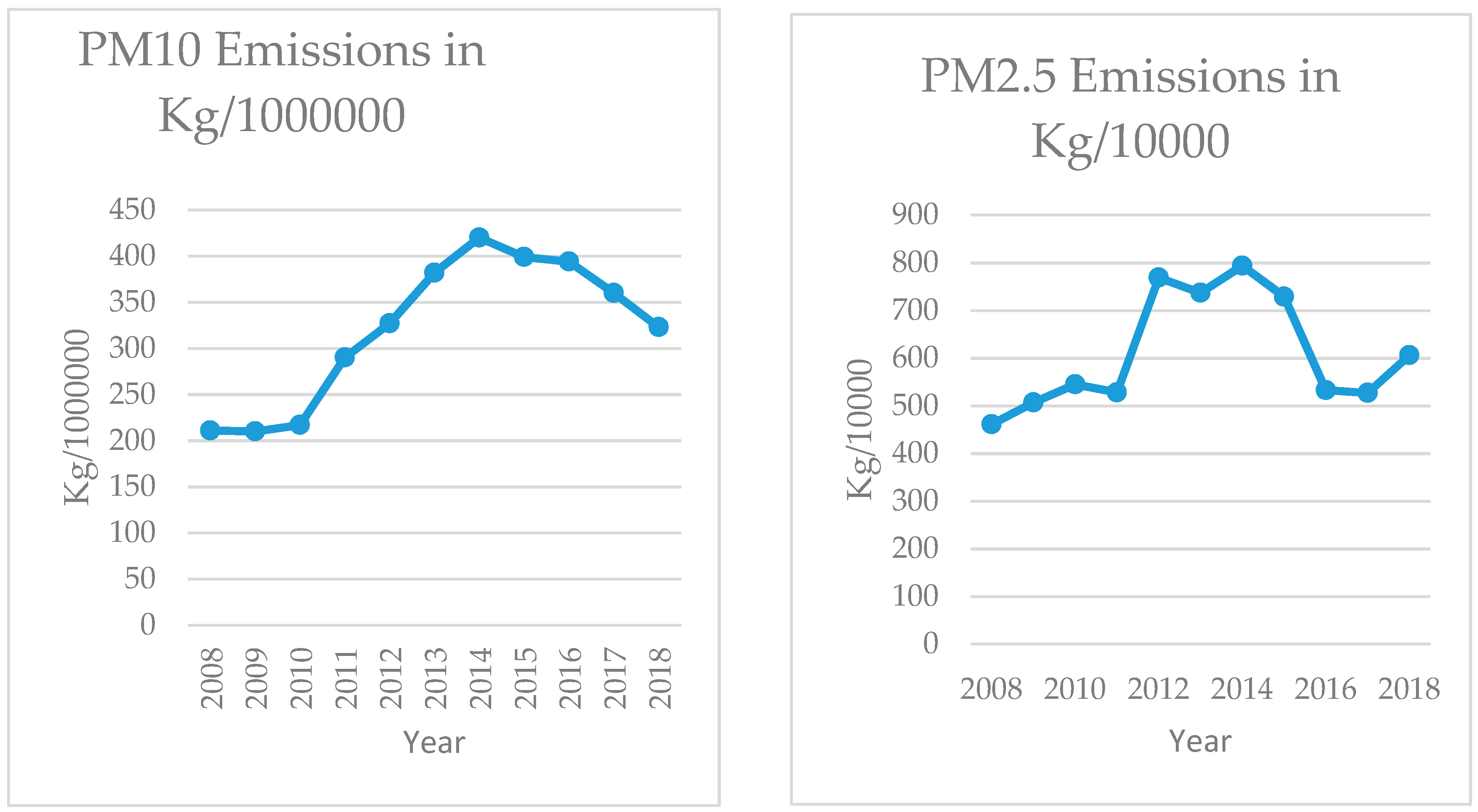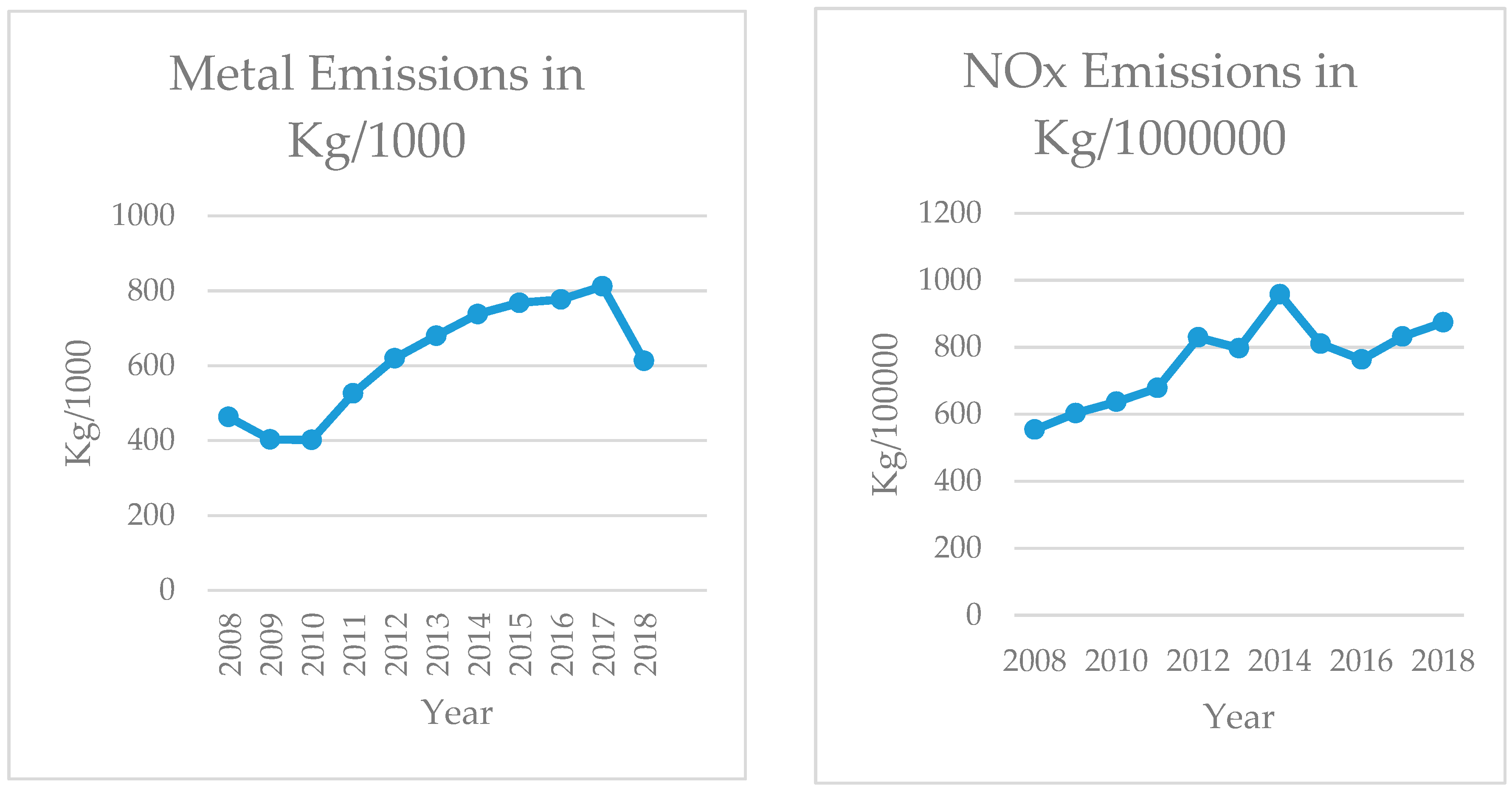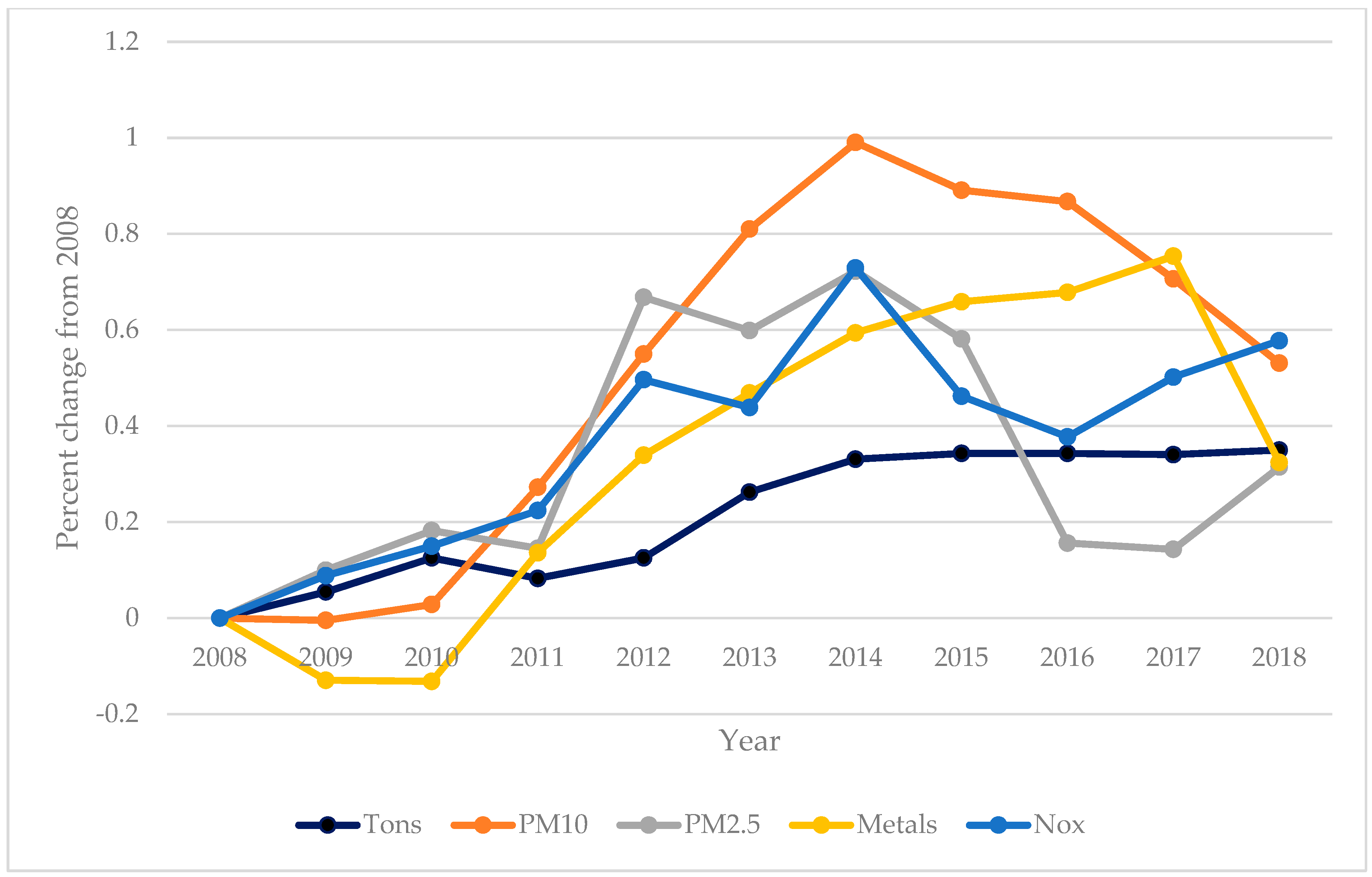Air Pollution Emissions 2008–2018 from Australian Coal Mining: Implications for Public and Occupational Health
Abstract
1. Introduction
2. Materials and Methods
2.1. Design
2.2. Data
2.3. Analysis
3. Results
4. Discussion
5. Conclusions
Author Contributions
Funding
Conflicts of Interest
References
- Nowrouzi-Kia, B.; Gohar, B.; Casole, J.; Chidu, C.; Dumond, J.; McDougall, A.; Nowrouzi-Kia, B. A systematic review of lost-time injuries in the global mining industry. Work 2018, 60, 49–61. [Google Scholar] [CrossRef]
- Perret, J.L.; Plush, B.; Lachapelle, P.; Hinks, T.S.; Walter, C.; Clarke, P.; Irving, L.; Brady, P.; Dharmage, S.C.; Stewart, A. Coal mine dust lung disease in the modern era. Respirology 2017, 22, 662–670. [Google Scholar] [CrossRef]
- Laney, A.S.; Weissman, D.N. Respiratory diseases caused by coal mine dust. J. Occup. Environ. Med. 2014, 56 (Suppl. 10), S18–S22. [Google Scholar] [CrossRef]
- Leon-Mejia, G.; Espitia-Perez, L.; Hoyos-Giraldo, L.S.; Da Silva, J.; Hartmann, A.; Henriques, J.A.; Quintana, M. Assessment of DNA damage in coal open-cast mining workers using the cytokinesis-blocked micronucleus test and the comet assay. Sci. Total Environ. 2011, 409, 686–691. [Google Scholar] [CrossRef]
- Petsonk, E.L.; Rose, C.; Cohen, R. Coal mine dust lung disease. New lessons from old exposure. Am. J. Respir. Crit. Care Med. 2013, 187, 1178–1185. [Google Scholar] [CrossRef] [PubMed]
- Laney, A.S.; Wolfe, A.L.; Petsonk, E.L.; Halldin, C.N. Pneumoconiosis and advanced occupational lung disease among surfce coal miners—16 states, 2010–2011. Morb. Mortal. Wkly. Rep. (MMWR) 2012, 61, 431–434. [Google Scholar]
- Ghose, M.K.; Majee, S.R. Characteristics of hazardous airborne dust around an Indian surface coal mining area. Environ. Monit. Assess. 2007, 130, 17–25. [Google Scholar] [CrossRef] [PubMed]
- Espitia-Perez, L.; Arteaga-Pertuz, M.; Soto, J.S.; Espitia-Perez, P.; Salcedo-Arteaga, S.; Pastor-Sierra, K.; Galeano-Paez, C.; Brango, H.; da Silva, J.; Enriques, J.A.P. Geospatial analysis of residential proximity to open-pit coal mining areas in relation to micronuclei frequency, particulate matter concentration, and elemental enrichment factors. Chemosphere 2018, 206, 203–216. [Google Scholar] [CrossRef] [PubMed]
- Kurth, L.M.; Kolker, A.; Engle, M.; Geboy, N.; Hendryx, M.; Orem, W.; McCawley, M.; Crosby, L.; Tatu, C.A.; Varonka, M.; et al. Atmospheric particulate matter in proximity to mountaintop coal mines: Sources and potential environmental and human health impacts. Environ. Geochem. Health 2015, 37, 529–544. [Google Scholar] [CrossRef] [PubMed]
- Cortes-Ramirez, J.; Naish, S.; Sly, P.D.; Jagals, P. Mortality and morbidity in populations in the vicinity of coal mining: A systematic review. BMC Public Health 2018, 18, 721. [Google Scholar] [CrossRef]
- Ahern, M.; Hendryx, M. Cancer mortality rates in Appalachian mountaintop coal mining areas. J. Occup. Environ. Sci. 2012, 1, 63–70. [Google Scholar] [CrossRef]
- Esch, L.; Hendryx, M. Chronic cardiovascular disease mortality in mountaintop mining areas of central Appalachian states. J. Rural Health 2011, 27, 350–357. [Google Scholar] [CrossRef] [PubMed]
- Hendryx, M.; Luo, J. An examination of the effects of mountaintop removal coal mining on respiratory symptoms and COPD using propensity scores. Int. J. Environ. Health Res. 2015, 25, 265–276. [Google Scholar] [CrossRef] [PubMed]
- Hendryx, M.; Higginbotham, N.; Ewald, B.; Connor, L.H. Air quality in association with rural coal mining and combustion in New South Wales Australia. J. Rural Health 2019, 35, 518–527. [Google Scholar] [CrossRef]
- Brown, J.S.; Gordon, T.; Price, O.; Asgharian, B. Thoracic and respirable particle definitions for human health risk assessment. Part. Fibre Toxicol. 2013, 10, 12. [Google Scholar] [CrossRef]
- Moreno, T.; Trechera, P.; Querol, X.; Lah, R.; Johnson, D.; Wrana, A.; Williamson, B. Trace element fractionation between PM10 and PM2.5 in coal mine dust: Implications for occupational respiratory health. Int. J. Coal Geol. 2019, 203, 52–59. [Google Scholar] [CrossRef]
- Islam, M.S.; Saha, S.C.; Sauret, E.; Gemci, T.; Yang, I.A.; Gu, Y.T. Ultrafine particle transport and deposition in a large scale 17-generation lung model. J. Biomech. 2017, 64, 16–25. [Google Scholar] [CrossRef][Green Version]
- Rothen-Rutishauser, B.M.; Kiama, S.G.; Gehr, P. A three-dimensional cellular model of the human respiratory tract to study the interaction with particles. Am. J. Respir. Cell Mol. Biol. 2005, 32, 281–289. [Google Scholar] [CrossRef]
- Oberdorster, G.; Oberdorster, E.; Oberdorster, J. Nanotoxicology: An emerging discipline evolving from studies of ultrafine particles. Environ. Health Perspect. 2005, 113, 823–839. [Google Scholar] [CrossRef]
- Islam, M.S.; Saha, S.C.; Sauret, E.; Gemci, T.; Gu, Y.T. Pulmonary aerosol transport and deposition analysis in upper 17 generations of the human respiratory tract. J. Aerosol. Sci. 2017, 108, 29–43. [Google Scholar] [CrossRef]
- Cullinan, P. Occupation and chronic obstructive pulmonary disease (COPD). Br. Med. Bull. 2012, 104, 143–161. [Google Scholar] [CrossRef] [PubMed]
- Cohen, R.A.; Petsonk, E.L.; Rose, C.; Young, B.; Regier, M.; Najmuddin, A.; Abraham, J.L.; Churg, A.; Green, F.H. Lung pathology in U.S. coal workers with rapidly progressive pneumoconiosis implicates silica and silicates. Am. J. Respir. Crit. Care Med. 2016, 193, 673–680. [Google Scholar] [CrossRef] [PubMed]
- Steenland, K.; Mannetje, A.; Boffetta, P.; Stayner, L.; Attfield, M.; Chen, J.; Dosemeci, M.; DeKlerk, M.; Hnizdo, E.; Koskela, R.; et al. Pooled exposure-response analyses and risk assessment for lung cancer in 10 cohorts of silica-exposed workers: An IARC multicentre study. Cancer Causes Control 2001, 12, 773–784. [Google Scholar] [CrossRef] [PubMed]
- Sim, M.; Glass, D.; Hoy, R.; Roberts, M.; Thompson, B.; Cohen, R.; Go, L.; Almberg, K.; Deponte, K. Review of Respiratory Component of the Coal Mine Workers’ Health Scheme for the Queensland Department of Natural Resources and Mines; Final Report; Monash Centre for Occupational and Environmental Health, Monash University, and School of Public Health, University of Illinois at Chicago: Chicago, IL, USA, 2016. [Google Scholar]
- Office of the Chief Economist (OCE). Australian Government Department of Industry Innovation and Science. 2019. Available online: https://publications.industry.gov.au/publications/resourcesandenergyquarterlydecember2018/index.html (accessed on 30 October 2019).
- National Pollutant Inventory (NPI). Australian Government Department of the Environment and Energy. 2018. Available online: www.npi.gov.au (accessed on 12 May 2019).
- National Pollutant Inventory (NPI). 2012. Available online: http://www.npi.gov.au/resource/emission-estimation-technique-manual-fugitive-emissions (accessed on 14 May 2019).
- National Pollutant Inventory (NPI). Emission Estimation Technique Manual for Mining; Version 3.1.; ACT, Australian Government, Department of Sustainability, Environment, Water, Population and Communities: Canberra, Australia, 2012.
- Office of Environment and Heritage (NSW). 2018. Available online: http://www.environment.nsw.gov.au/topics/air/monitoring-air-quality (accessed on 8 May 2018).
- Queensland Government 2020. Available online: https://www.qld.gov.au/environment/pollution/monitoring/air/air-monitoring (accessed on 22 January 2020).
- Australian Bureau of Statistics (ABS). 2019. Available online: https://quickstats.censusdata.abs.gov.au/census_services/getproduct/census/2016/quickstat/POA4615?opendocument (accessed on 15 November 2019).
- Lu, F.; Xu, D.; Cheng, Y.; Dong, S.; Guo, C.; Jiang, X.; Zheng, X. Systematic review and meta-analysis of the adverse health effects of ambient PM2.5 and PM10 pollution in the Chinese population. Environ. Res. 2015, 136, 196–204. [Google Scholar] [CrossRef]
- Krewski, D.; Jerrett, M.; Burnett, R.T.; Ma, R.; Hughes, E.; Shi, Y.; Turner, M.C.; Pope, C.A.; Thurston, G.; Calle, E.E.; et al. Extended follow-up and spatial analysis of the American Cancer Society study linking particulate air pollution and mortality. Res. Rep. Health Eff. Inst. 2009, 5–144, 5–36. [Google Scholar]
- Wellenius, G.A.; Schwartz, J.; Mittleman, M.A. Particulate air pollution and hospital admissions for congestive heart failure in seven United States cities. Am. J. Cardiol. 2006, 97, 404–408. [Google Scholar] [CrossRef]
- Lequy, E.; Siemiatycki, J.; Leblond, S.; Meyer, C.; Zhivin, S.; Vienneau, D.; de Hoogh, K.; Goldberg, M.; Zins, M.; Jacquemin, B. Long-term exposure to atmospheric metals assessed by mosses and mortality in France. Environ. Int. 2019, 129, 145–153. [Google Scholar] [CrossRef]
- Cliff, D.; Kizil, G. An estimate of the exposure of Queensland underground longwall workers to respirable dust. In Proceedings of the Queensland Mining Industry Health and Safety Conference, Townsville, Queensland, Australia, 4–7 August 2002. [Google Scholar]
- Kurth, L.M.; McCawley, M.A.; Hendryx, M.; Lusk, S. Atmospheric particulate matter size distribution and concentration in West Virginia coal mining and non-mining areas. J. Exp. Science Environ. Epidem. 2014, 24, 405–411. [Google Scholar] [CrossRef]
- Knuckles, T.; Stapleton, P.; Minarchick, V.; Esch, L.; McCawley, M.A.; Hendryx, M.; Nurkiewicz, T.R. Air pollution particulate matter collected from an Appalachian mountaintop mining site induces microvascular dysfunction. Microcirculation 2013, 20, 158–169. [Google Scholar] [CrossRef]
- Hou, W.; Xu, X.; Lei, Y.; Cao, J.; Zhang, Y.; Chen, L.; Huo, X. The role of the PM2.5-associated metals in pathogenesis of child Mycoplasma Pneumoniae infections: A systematic review. Environ. Sci. Pollut. Res. Int. 2016, 23, 10604–10614. [Google Scholar] [CrossRef]
- Siddika, N.; Balogun, H.A.; Amegah, A.K.; Jaakkola, J.J. Prenatal ambient air pollution exposure and the risk of stillbirth: Systematic review and meta-analysis of the empirical evidence. Occup. Environ. Med. 2016, 73, 573–581. [Google Scholar] [CrossRef] [PubMed]
- Zeng, X.W.; Vivian, E.; Mohammed, K.A.; Jakhar, S.; Vaughn, M.; Huang, J.; Zelicoff, A.; Xaverius, P.; Bai, Z.; Lin, S.; et al. Long-term ambient air pollution and lung function impairment in Chinese children from a high air pollution range area: The Seven Northeastern Cities (SNEC) study. Atmos. Environ. 2016, 138, 144–151. [Google Scholar] [CrossRef]
- Cooper, N.; Green, D.; Meissner, K.J. The Australian National Pollutant Inventory fails to fulfil its legislated goals. Int. J. Environ. Res. Public Health 2017, 14, 478. [Google Scholar] [CrossRef]
- Hendryx, M. The public health impacts of surface coal mining. Extr. Ind. Soc. 2015, 2, 820–826. [Google Scholar] [CrossRef]
- Thurston, G.D.; Burnett, R.T.; Turner, M.C.; Shi, Y.; Krewski, D.; Lall, R.; Ito, K.; Jerrett, M.; Gapstur, S.M.; Diver, W.R. Ischemic heart disease mortality and long-term exposure to source-related components of U.S. fine particle air pollution. Environ. Health Perspect. 2016, 124, 785–794. [Google Scholar] [CrossRef] [PubMed]




| Emission | N of Observations | Total Amount in kg |
|---|---|---|
| Antimony and compounds | 741 | 7402.5 |
| Arsenic and compounds | 985 | 44,023.9 |
| Beryllium and compounds | 902 | 12,776.9 |
| Cadmium and compounds | 866 | 2299.9 |
| Chromium (VI) and compounds | 107 | 1565.7 |
| Cobalt and compounds | 967 | 74,179.6 |
| Copper and compounds | 1089 | 241,099.8 |
| Lead and compounds | 1102 | 153,289.6 |
| Manganese and compounds | 1161 | 4,844,927.9 |
| Mercury and compounds | 1114 | 1393.3 |
| Nickel and compounds | 1090 | 281,789.1 |
| Selenium and compounds | 667 | 9982.4 |
| Zinc and compounds | 1117 | 1,127,249.7 |
| Total Metals | 11,908 | 6,801,980.3 |
| PM2.5 | 1071 | 67,361,544.1 |
| PM10 | 1082 | 3,534,238,028.0 |
| NOx | 1074 | 833,567,946.0 |
| Post Code | PM10 Emissions (kg) | Population (2016) |
|---|---|---|
| 2330 | 517,080,520 | 20,350 |
| 4744 | 487,372,265 | 8735 |
| 4742 | 393,371,886 | 1140 |
| 4717 | 320,200,354 | 4749 |
| 4746 | 234,138,583 | 1935 |
| 4745 | 224,807,477 | 2991 |
| 2333 | 195,740,657 | 13,647 |
| 4718 | 152,534,402 | 2375 |
| 4720 | 104,375,624 | 14,394 |
| 4715 | 84,736,324 | 7127 |
| 2382 | 83,557,341 | 1319 |
| 4743 | 81,607,887 | 620 |
| 4702 | 75,395,426 | 28,609 |
| 4721 | 71,774,189 | 3717 |
| 2850 | 63,454,014 | 17,644 |
| 4741 | 52,933,785 | 7079 |
| 4804 | 47,928,470 | 1,730 |
| 4401 | 45,444,892 | 5719 |
| 6225 | 41,986,061 | 9105 |
| 4615 | 28,489,238 | 7052 |
| Emission | Percent of National Air Emissions from Coal Mines | Total National Air Emissions (kg) |
|---|---|---|
| Metals | 12.1% | 56,120,926.2 |
| NOx | 10.1% | 8,267,252,710 |
| PM2.5 | 19.5% | 344,873,749 |
| PM10 | 42.1% | 8,404,128,401 |
| Emission | Coal Mines | Other NPI Sites | p < * |
|---|---|---|---|
| Metals | 571.2 (24.1) | 485.6 (36.4) | 0.05 |
| NOx | 776,134 (30,071) | 358,423 (14,890) | 0.0001 |
| PM2.5 | 62,896 (2626) | 13,943 (597) | 0.0001 |
| PM10 | 3,266,394 (136,801) | 235,807 (9354) | 0.0001 |
| Group | N of Monitoring Sites | Mean | Standard Deviation | p < * |
|---|---|---|---|---|
| Mining | 19 | 20.71 | 3.79 | <0.02 |
| Nonmining urban | 45 | 17.36 | 4.53 | |
| Nonmining rural | 12 | 16.04 | 6.26 |
© 2020 by the authors. Licensee MDPI, Basel, Switzerland. This article is an open access article distributed under the terms and conditions of the Creative Commons Attribution (CC BY) license (http://creativecommons.org/licenses/by/4.0/).
Share and Cite
Hendryx, M.; Islam, M.S.; Dong, G.-H.; Paul, G. Air Pollution Emissions 2008–2018 from Australian Coal Mining: Implications for Public and Occupational Health. Int. J. Environ. Res. Public Health 2020, 17, 1570. https://doi.org/10.3390/ijerph17051570
Hendryx M, Islam MS, Dong G-H, Paul G. Air Pollution Emissions 2008–2018 from Australian Coal Mining: Implications for Public and Occupational Health. International Journal of Environmental Research and Public Health. 2020; 17(5):1570. https://doi.org/10.3390/ijerph17051570
Chicago/Turabian StyleHendryx, Michael, Mohammad Saidul Islam, Guang-Hui Dong, and Gunther Paul. 2020. "Air Pollution Emissions 2008–2018 from Australian Coal Mining: Implications for Public and Occupational Health" International Journal of Environmental Research and Public Health 17, no. 5: 1570. https://doi.org/10.3390/ijerph17051570
APA StyleHendryx, M., Islam, M. S., Dong, G.-H., & Paul, G. (2020). Air Pollution Emissions 2008–2018 from Australian Coal Mining: Implications for Public and Occupational Health. International Journal of Environmental Research and Public Health, 17(5), 1570. https://doi.org/10.3390/ijerph17051570








